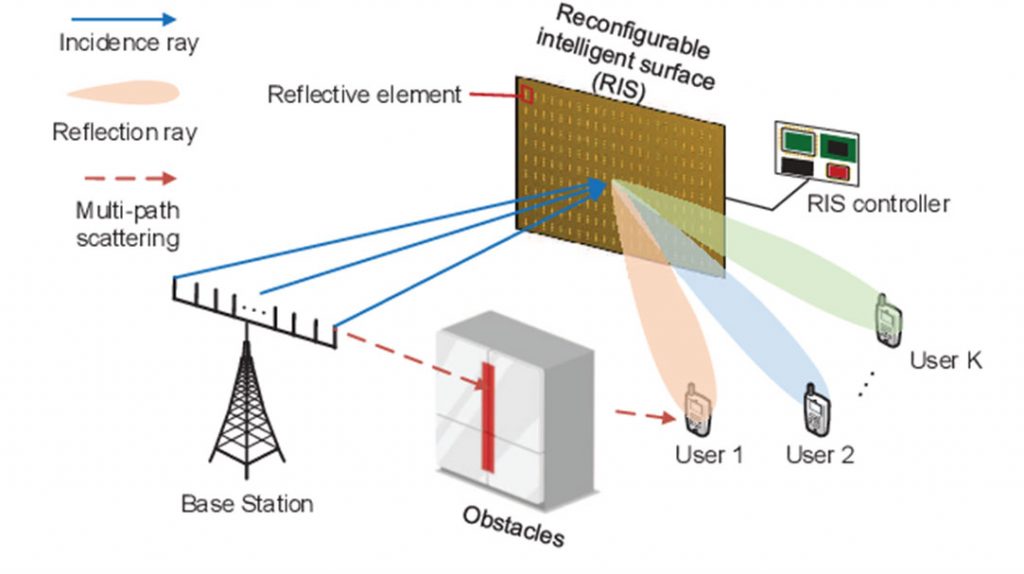
The initial step in the operation of reconfigurable intelligent surfaces or intelligent transmitters consisting of metasurfaces involves the absorption of a directed signal, avoiding multipath propagation and fading, which subsequently undergoes processing by a microcontroller. Following this, the signal is regenerated and transmitted in a predetermined direction through the utilization of antenna arrays and meta surfaces. Henceforth, these devices possess the capability to augment the accessibility of cellular or GNSS signals in regions where their natural accessibility is otherwise limited. The utilization of signal deflection can also serve the purpose of reducing the length of the signal’s trajectory towards the recipient, thereby optimizing the efficacy of the network infrastructure. As the utilization of frequency bands pertaining to 5G and 6G ventures into the realm of millimeter waves and terahertz frequencies, the demand for Reconfigurable Intelligent Surfaces (RIS) is poised to escalate. This phenomenon arises due to the limited propagation range and reduced ability to penetrate obstacles exhibited by signals within these frequency bands, in contrast to the sub-6 GHz signal employed by prevalent cellular technologies such as 3G, 4G, and sub-6 GHz 5G. In order to effectively penetrate buildings and various structures, it becomes imperative to employ artificial means of directing high-frequency signals, such as the utilization of Reconfigurable Intelligent Surfaces (RISs).
The area of digital signal processing and digital communication have recently witnessed the demand in the rise of a plethora of communication technologies. Remarkable examples include use of MIMO signaling and non-orthogonal multiple access (NOMA), communications and sensing integration, sparse vector coding, index modulation, and other similar developments that go beyond the capabilities of traditional methods. With the arrival of 6G wireless networks, wireless communication systems and technologies, especially those operating at the physical layer, must undergo a thorough evaluation. The recent construction of 5G wireless networks, which have exhibited a wide variety of uses, has created this necessity in the cellular business. This blog makes an academic attempt to explain the emerging concept of RIS-enabled communications as it pertains to 6G wireless networks.
MORE ABOUT RECONFIGURABLE INTELLIGENT SURFACES AND THEIR FUTURE.
The reconfigurable intelligent surface (RIS) is being assessed as a pivotal element in the pursuit of establishing an intelligent radio environment reducing the latency at the recipient and overall improve in QOS. A Radio Frequency Identification System (RIS) is comprised of economically viable passive reflective components, such as printed dipoles. Each of these constituent elements possesses the capability to elicit a programmable alteration in the phase of the incoming electromagnetic wave, thereby facilitating the implementation of passive beamforming techniques with the objective of enhancing the power of the received signal. When effectively managed, a Radio Interface System (RIS) aids in the synchronization of signals received by the receiver, thereby leading to a manageable radio environment. Hence, the utilization of reconfigurable intelligent surfaces (RIS) has the potential to augment the beam-forming gain within a massive multiple-input multiple-output (MIMO) framework. This is achieved through the RIS functioning as a reflective medium for the initial beam emitted by the transmitter, thereby altering its trajectory towards the intended recipient. The inherent nature of a RIS, consisting solely of passive elements, renders it incapable of surpassing the performance capabilities of a conventional repeater in the classical sense. Nevertheless, the inherent economic advantage and superior energy efficiency render them a highly appealing substitute. The primary aim of RIS, or Reconfigurable Intelligent Surfaces, is to optimize the reception quality for the recipient beyond the inherent capabilities it would have exhibited in the absence of such surfaces. In contrast to a bonafide base station, a reconfigurable intelligent surface (RIS) lacks the inherent capability to receive and analyze the channel state information (CSI) report originating from the terminal receiver. The transmitter must engage in a collaborative optimization process that encompasses both the transmission link between the transmitter and the reconfigurable intelligent surface (RIS), specifically the configuration of transmit beamforming between the transmitter and RIS, as well as the reflective link between the RIS and the receiver, which involves determining the appropriate passive beamforming configuration to be applied on the RIS. From a technical standpoint, it is imperative for the transmitter to engage in an exhaustive exploration of all conceivable amalgamations involving the transmission beamforming antennas and the passive beamforming configurations of the reconfigurable intelligent surface (RIS). Subsequently, the transmitter must discern the most advantageous configuration by judiciously evaluating the feedback received from the receiver for each individual combination. This particular quandary can be classified as non-convex in nature, thereby rendering it computationally arduous and susceptible to significant delays. As we contemplate the advancements in average signal-to-interference-plus-noise ratio (SINR) and cellular coverage facilitated by reconfigurable intelligent surfaces (RIS), it becomes evident that there exist additional facets that necessitate meticulous examination. The successful implementation of utilizing RIS within a specific geographic area facilitates the establishment of inter-operator coordination.
Dr. Chitra Kiran. N
Professor, Department of ECE,
ACED, Alliance University, Bangalore
